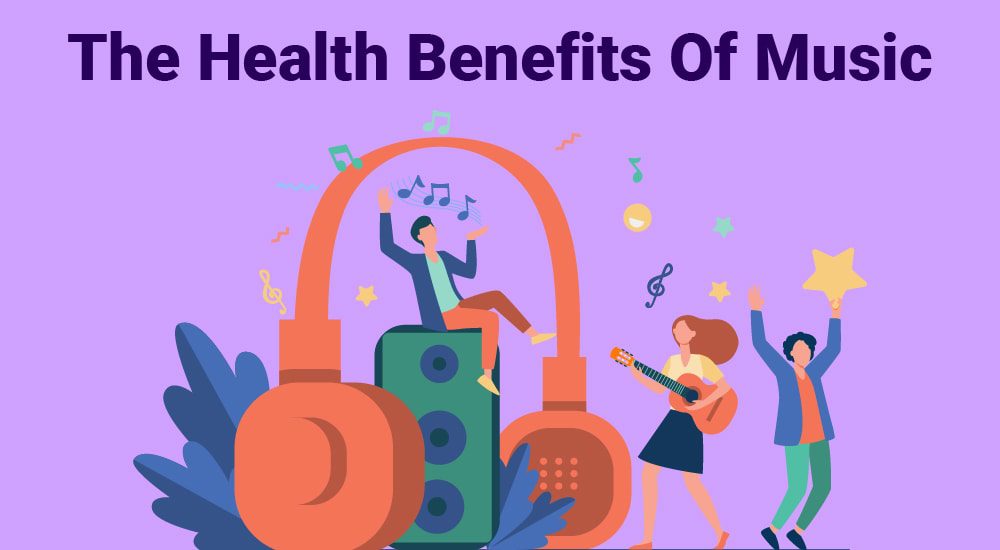Table of Contents
Introduction
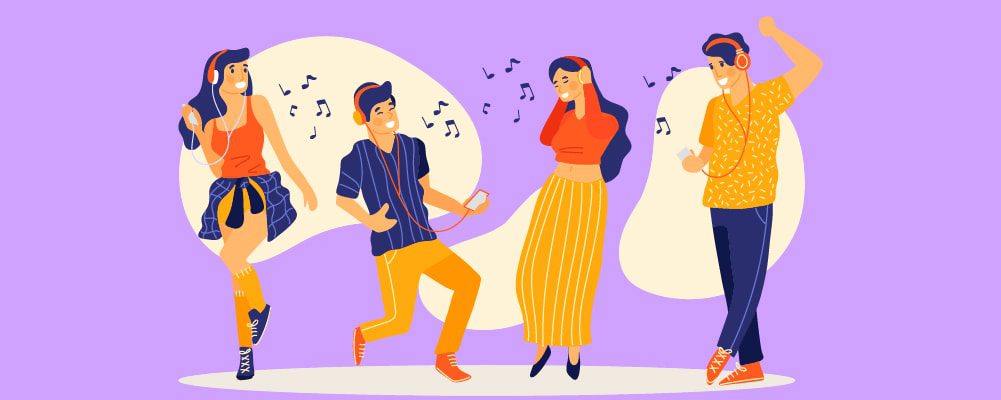
Music is one of those magical things that has the power to stir our emotions, motivate us, and take us to a place that words alone simply cannot manage.
But, one thing that not many people know is that the powerful chords and melodies of our favorite musical offerings can actually benefit our health.
Mental health and physical health can both be improved using music as a tool.
And, as the world becomes a more demanding, stressful place to live, there’s never been a better time to turn to music to calm our minds, elevate our mood, and improve our overall well-being.
If you’d like to know more about how you can use music to improve your health, you’ve come to the right place!
Below, we’ll take a look at the plethora of different types of sound, as well as the health benefits that certain specific types of music can provide.
Types Of Sounds And Music

Let’s begin by taking a look at the different types of sounds and music. This goes a little deeper than the usual tunes you’re used to hearing on your radio.
In fact, there are loads of sound genres that you may never have even heard of before.
Solfeggio Frequencies
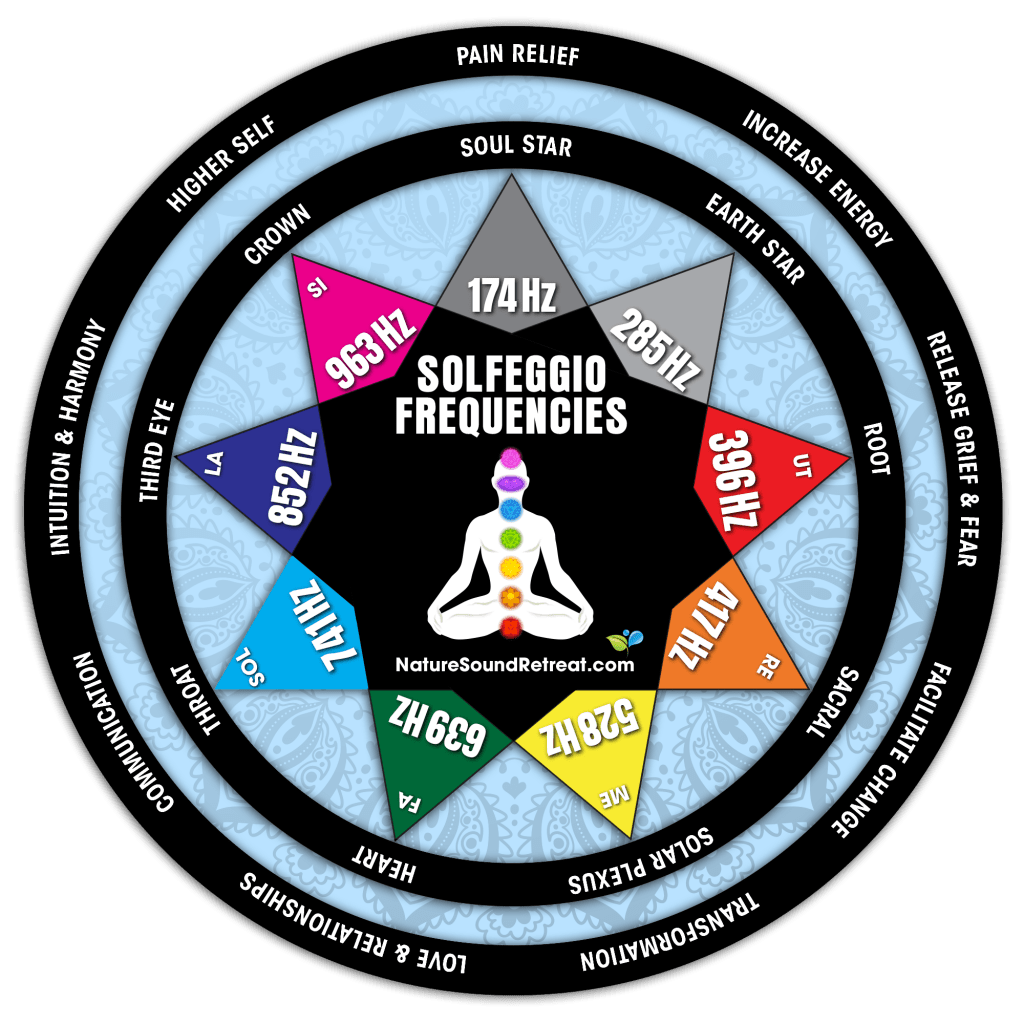
The unique tones of Solfeggio frequencies were thought to manifest spiritual blessings when sung in harmony, and each tone comprises a frequency that helps to balance your energy.
The result is your body, mind, and spirit existing together in perfect harmony. There are six main Solfeggio frequencies, each of which has a specific meaning:
| COLOR | FREQUENCY | INTENT | CHAKRA | ELEMENT | ||
|---|---|---|---|---|---|---|
| SI | MAGENTA | 963 Hz | Connect to Higher Self / Oneness | 7th | Crown | |
| LA | PURPLE / INDIGO | 852 Hz | Intuition & Harmony | Third Eye |
6th | Light |
| Associated Body Parts: Pituitary & Pineal Glands, Hypothalamus, Nose, Eyes and Nervous System | ||||||
| Related Dysfunctions: Blindness, Headaches, Eye Strain, Blurred Vision, Nightmares, Sinus Problems, Lack of Concentration | ||||||
| SOL | BLUE | 741 Hz | Expression & Communication | 5th | Throat | Ether |
| Associated Body Parts: Thyroid, Thoart, Oesophagus, Larynx, Neck and Shoulders, Auditory System | ||||||
| Related Dysfunctions: Thyroid Problems, Sluggish Metabolism, Weight Problems, Hearing Problems, Sore Throat, Stiff Neck and Colds | ||||||
| FA | GREEN | 639 Hz | Love & Relationships | 4th | Heart | Air |
| Associated Body Parts: Thymus, Heart, Lungs, Breasts, Immune System, Circulatory System & Resporatory System | ||||||
| Related Dysfunctions: Asthma, High Blood Pressure, Heart Disease/Problems, Lung Disease, Lack of Self-Love, Loneliness, Circulation | ||||||
| MI | GOLD / YELLOW | 528 Hz | Transformation & Miracles | GOLD / YELLOW | GOLD / YELLOW | GOLD / YELLOW |
| Associated Body Parts: Pancreas, Digestion, Liver, Gallbladder, Stomach, Nervous System and Muscles | ||||||
| Related Dysfunctions: Ulcers, Diabetes, Hypoglycaemia, Digestive Disorders, Gallstones, Fatigue, Anxiety and Negative Thoughts | ||||||
| RE | ORANGE | 417 Hz | Release Negativity & Facilitate Change | 2nd | Sacral | Water |
| Associated Body Parts: Kidneys, Bladder, Pelvic Area, Sex Glands, Reproductive System, Prostate | ||||||
| Related Dysfunctions: Impotence, Frigidity, Uterine/Baldde/Kidney Problems, Stiff Lower Back | ||||||
| UT | RED | 396 Hz | Eliminate Fear & Guilt | 1st | Root | Earth |
| Associated Body Parts: Adrenals, Base of Spine, Legs, Feet, Bones, Teeth, Large Intestines, Blood & Circulation, Elimintation | ||||||
| Related Dysfunctions: Weight Problems, Hemmorrhoids, Constipation, Sciatica, Arthritis, Knee Problems, Insecurity and Fear | ||||||
| 285 Hz | Build Energy & Heal | Earth Star | ||||
| UT | UT | 174 Hz | Pain Relief & Stress Relief | Soul Star | ||
- 396Hz: This Solfeggio frequency helps us address our innermost problems to liberate us from fear and guilt.
- 417Hz: Helps seek positive change and make progress towards our goals.
- 528Hz: Seeks healing through DNA alterations outside of the limitations of modern medicine.
- 639Hz: This Solfeggio frequency allows us to connect and reconnect with other people.
- 714Hz: This is the problem-solving Solfeggio frequency that allows us to express our feelings and come up with solutions to our problems.
- 852Hz: Helps us restore spiritual order and, ultimately, unlock our potential by getting closer to our spiritual self.
Solfeggio frequencies are commonly used with chakra meditation techniques, as both practices follow a similar method.
Each chakra point is assigned to a specific area of our life, and Solfeggio frequencies work the same way. Below, you will find which Solfeggio frequency is best suited for a specific chakra point:
- Root Chakra / 396Hz: These two work together to reflect the vibrational tone of the earth and liberate us from fear, guilt, and help us pursue our needs.
- Sacral Chakra / 417Hz: When combined, these reflect the tone of the lunar cycle and help strengthen our desire for change and progress, while strengthening our creativity.
- Solar Plexus Chakra / 528Hz: This combination of chakra healing and Solfeggio frequency reflects the tone of the sun, allowing for transformation and miracles by repairing our DNA.
- Heart Chakra / 639Hz: Reflects the tone of the Earth’s year to help us connect with other people and strengthen relationships.
- Throat Chakra / 741Hz: Awakens our intuition and leads to establishing better communication skills with others by reflecting the tone of the planet Mercury.
- Third-Eye Chakra / 852Hz: Reflects the tone of the planet Venus and allows us to return to our spiritual order by unlocking the unconscious elements of the mind.
There are specific colors associated with each chakra, as well.
By incorporating these colors (whether it’s through crystals or basic chakra color swatches) and placing them on certain parts of your bord, along with listening to Solfeggio frequencies, you can strengthen your chakras even more effectively.
The colors associated with each chakra are:
| Chakra | Color | Location | Meaning |
| Root | Red | Base of the spine | Physical needs, anger, passion |
| Sacral | Orange | Lower abdomen | Joy, vitality, creativity |
| Solar Plexus | Yellow | Solar plexus (middle of the abdomen) | Power, self-confidence |
| Heart | Green | Heart | Love, peace, compassion |
| Throat | Blue | Throat | Communication, keeping true to one’s self |
| Third Eye | Indigo | Brow | Intuition, understanding |
| Crown | Violet | Top of the head | Peace, oneness |
Gregorian Chants

Gregorian chants are most commonly associated with religious music and, to this day, they are still practiced in many places of worship all over the world.
You can also incorporate
Gregorian chanting into yoga, in a practice known as “Kirtan”.
Gregorian chants are divided into different types of chants based on the number of notes each syllable has.
- Syllabic Chants: These mostly have one note per syllable.
- Neumatic Chants: These have two or three notes to each syllable.
- Melismatic Chants: These have lots of notes for each syllable.
But how do each of these types of Gregorian chants benefit our health? Well, a study published in 2016 showed that chanting can bring positive psychological changes.
This makes it a fantastic meditation tool for improving our mental health and relieving anxiety.
ASMR
Also known by its longer name of ‘Automated Sensory Meridian Response’, ASMR falls into the sound category rather than music.
It’s become quite famous over recent years with online influencers creating their own ASMR videos, and there are many different forms of ASMR. These include whispered spoken-word, tapping, scratching, and crinkling sounds.
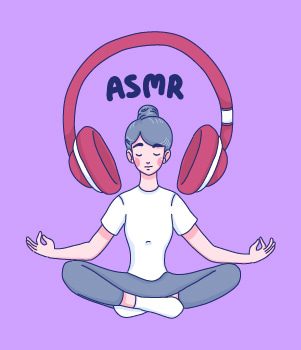
Whichever sounds most appealing, they all have one thing in common; they produce a spine-tingling sensation. This feeling most commonly starts at the top of the head and then spreads its way throughout the body.
But how does this benefit our health? Research has suggested that ASMR lowers your heart rate and improves your overall health and well-being.
Nature Sounds

Turn off all technology, remove the hustle and bustle of the outside world, and you’ll be left with the sounds of nature.
This could be rainfall, a babbling brook, or birds chirping in the distance.
Each of these, along with other nature sounds, relaxes us and can promote sleep as our brain considers them as non-threatening sounds.
A recent study also found that people that live in areas with high levels of nature sounds showed improved health, decreased pain, and enhanced cognitive performance.
Of course, it’s not that easy to reconnect with nature sounds when you live in a busy city.
But, thanks to streaming services and sound machines, listening to nature sounds is as easy as building a playlist and letting it soothe your mind.
Isochronic Tones
Just like ASMR, Isochronic tones are becoming an increasingly popular form of sound therapy.
But what are they, exactly?
To put it simply, isochronic tones are a way to stimulate your brain quickly and effectively while changing your brainwave frequency.
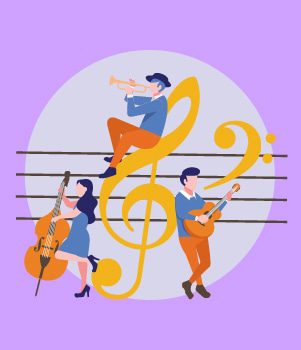
As far as the sound of isochronic tones is concerned, they are consistent, regular beats of a single tone that are often set to music.
The speed of the tone is measured in Hertz, and a 10Hz isochronic tone will be repeated 10 times over a 1-second period. This creates a fast, repeated, pulsating beat.
Isochronic tones work by utilizing ‘brainwave entrainment’. This process influences our brain wave activity and allows us to achieve a desired mental state, as our brainwave frequency begins to replicate the repetitive tone.
Isochronic tones are a great sound-based tool for relieving stress or anxiety, increasing your focus, and improving sleep.
Binaural Beats
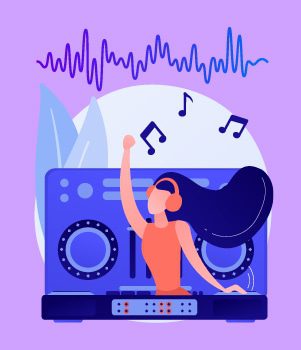
If you’ve been looking into isochronic tones as a form of sound therapy, you may also have encountered binaural beats.
These are different from isochronic tones as the beat is continuous, while an isochronic tone is turned on and off at a fast pace.
Binaural beats also use two tones with a slightly different frequency fed into each ear. These are then processed by your brain and the perception of a specific beat is achieved.
So, for example, a tone of 330Hz may be fed into your left ear while a tone with a 300Hz frequency is fed into your right ear. As these are processed by your brain, the result is a perceived beat of 30Hz.
Another thing that sets binaural beats apart from isochronic tones is that you can’t target a specific side of the brain. Instead, the entire brain is stimulated.
Since two different frequencies are being fed into each ear, you also need to always use headphones when listening to binaural beats.
Despite these differences, the health benefits of binaural beats are pretty much the same as isochronic tones and they can be used to ease anxiety, stress, and help improve sleep.
Brainwave Entrainment
Both isochronic tones and binaural beats fall into the ‘brainwave entrainment’ category.
To put it in the simplest terms possible, brainwave entrainment is a way of synchronizing your brain waves with the desired frequency to achieve a certain state of mind.
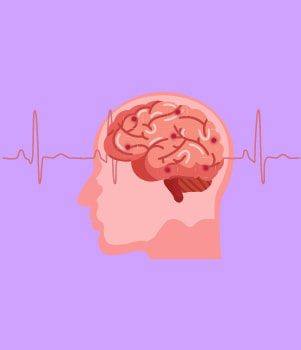
Listening to brainwave entrainment through isochronic tones or binaural beats allows both hemispheres of our brain to synchronize to the same frequency, rather than working independently from one another.
And, when the electrical energy in your brain is balanced and both hemispheres are at the same frequency, several health benefits are achieved. These include:
- Reduced stress and anxiety
- Memory improvement
- Reduced fatigue
- Improved sleep
- Improved immune system function
- Improved athletic performance
- Improved focus
To achieve these, however, it is important that you’re using brainwave entrainment that is matched to the frequency of certain brain waves. We’ll take an in-depth look at this below.
Alpha, Beta, Delta, Theta Waves
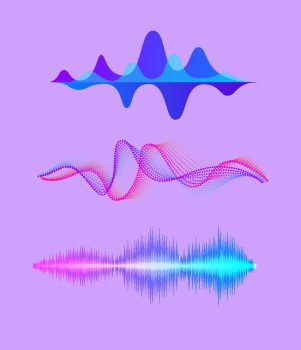
To truly understand how brainwave entrainment works, as well as how other types of sound and music can benefit our health, we need to take a look at brainwave frequencies.
Our brainwave frequencies reflect our emotional and physical state. When we feel sleepy and relaxed, we have a higher number of slower brain waves.
When we are energized or focused on something, we have a higher number of faster brain waves.
When it comes to brainwave entrainments such as isochronic tones and binaural beats, we can stimulate and produce a specific frequency that makes certain brain waves more dominant.
So, for example, if you were feeling particularly stressed, listening to slower-speed isochronic tones will help to calm you and reduce your stress levels.
Brainwave frequencies are categorized into different states, and by understanding these categories you can choose the best type of brain entrainment frequency to influence your brainwave activity.
Let’s take a look at each of these categories in more detail:
- Alpha Waves: These have a frequency of 8Hz – 12Hz and when alpha waves are more dominant you’ll usually find yourself feeling calm and relaxed. So, listening to brainwave entrainment with a frequency of 8Hz-12Hz will reduce stress and anxiety. It can also help to stimulate creativity and improve your ability to memorize information.
- Beta Waves: Beta waves are more dominant during the day when we are awake, focused, and energized. They have a 12Hz – 40Hz frequency, and listening to brainwave entrainment within this frequency will increase the number of beta waves your brain produces and allow you to become more alert and awake when needed.
- Delta Waves: These are very slow and low and have a 0.5Hz – 4Hz frequency. Delta waves are most present when you’re in a deep sleep, and when your body is rested enough to heal and regenerate cells. If you need help getting into a deep sleep, listening to brainwave entrainment with a 0.5Hz – 4Hz frequency will encourage delta waves to dominate your brain.
- Theta Waves: Theta waves are also dominant while you’re sleeping and they also encourage us into a deep sleep. They have a low 4Hz – 8Hz frequency so, again, listening to brainwave entrainment within this frequency will improve your chances of achieving a deep state of relaxation and drifting off to sleep naturally.
White Noise
You may have come across the term ‘white noise’ before, and you’ve probably even heard it without even realizing it.
White noise is that buzzing sound you hear when you’re trying to switch between radio stations or when your television connection suddenly cuts out.

White noise is created when many frequencies combine with the same level of intensity at once. It’s also one of those ‘love it or hate it’ noises.
Some people find the buzzing sound relaxing, while other people can find it to be extremely annoying.
However you feel about white noise, some health benefits come from listening to it including improved sleep. It’s even been shown to improve focus and concentration in children with ADHD.
Ambient Music
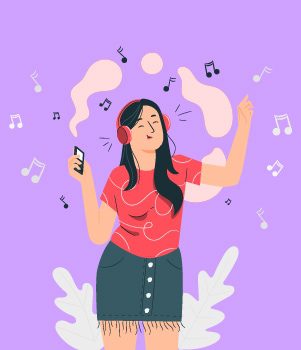
Ambient music allows us to fully immerse ourselves in a musical-healing environment.
It’s also quite an eclectic form of music.
It can be classical or electronic, but the one thing that all types of ambient music have in common is that there is no persistent beat.
By removing a repetitive beat, the music is able to enhance our mood or transport us to a certain atmospheric feeling.
It’s this ability that makes ambient music a great tool for relaxing and healing, and it’s particularly useful if you struggle to get to sleep at night.
It’s not just good for relaxing, though. Some ambient music is designed to energize and motivate us, which makes it a great listening choice for working out or running.
And, as we all know, our health is greatly improved when we undertake regular exercise.
Meditation Music
Meditation music isn’t all that different from ambient music, but it’s much more focused on relaxing the body and mind.
This makes it a great choice for relieving stress, stretching after a yoga session, or calming your mind before you settle into bed for the night.

Listening to meditation music can help you focus your mind too, which makes it a good choice for studying or any other task where you really need your concentration to be at a peak level. It’s also been shown to improve your cognitive abilities.
Classical Music
Whether it’s swelling instrumentals or lighter, solo-violinist tracks, there are multiple health benefits associated with listening to classical music. To begin with, it can decrease your cortisol levels and lower your blood pressure.
Classical music also helps to aid with sleep.
So, if you’ve found that nature sounds and meditation music simply aren’t working for you, classical music is a great alternative to try out. Here are some of the best classical music tracks for falling asleep to:
- Satie – “Gymnopédie No.1”
- Holst – “Venus the Bringer of Peace (The Planets)”
- Chopin – “Nocturne No.2, Op.9”
- Ravel – “Piano Concerto in G Major (2nd movement)”
- Beethoven – “Moonlight Sonata (1st movement)”
- Bill Evans – “Peace Piece”
- J.S Bach – “Prelude No.1”
- Massenet – “Meditation”
- Debussy – “Rêverie”
- Mozart – “Concerto for Flute and Harp (2nd movement)”
Classical music also has some health benefits for babies, in the form of The Mozart Effect.
To put it in its simplest terms, The Mozart Effect shows that babies and younger children who were regularly exposed to classical music had increased cognitive development.
Benefits of Specific Music Types
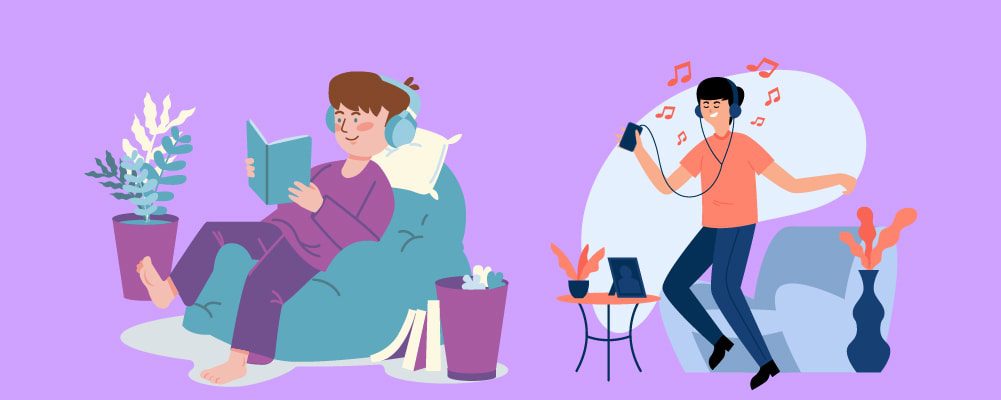
On our journey through the different types of sounds and music, we’ve touched on their health benefits and how each of them is ideal for helping you improve a certain element of your life.
However, not all of them are suitable for certain things. So, to make things easier and to help you discover what type of music or sounds you should be listening to, we’ll take a look at the health benefits of specific music types.
Sleep
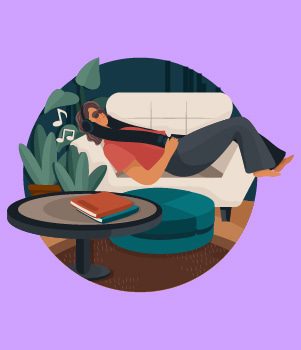
If you struggle to get to sleep at night or find it difficult to maintain a deep sleep, there are loads of types of music that can help you.
Let’s explore them in more detail below, and explain exactly why each of them is so good for helping you beat insomnia.
- ASMR: The tingling sensation that comes from listening to ASMR sounds helps you fall asleep by relaxing your body and reducing your stress levels. And, as our stress levels fall, so do our cortisol levels. The lower our cortisol levels are, the more likely we are to have a good night’s sleep.
- Nature Sounds: Listening to nature sounds at night time presents as non-threatening sounds to our brain. This means that we’re able to not only fall asleep more peacefully, but we’re unlikely to get shocked awake in the middle of the night.
- Isochronic Tones: Isochronic tones that are played at the same frequency as our Delta and Theta brain waves allow us to create a dominance of relaxing, sleep-inducing brainwave frequencies. This makes it much easier to fall asleep and remain in a deep sleep throughout the night.
- Binaural Beats: As with isochronic tones, binaural beats allow us to alter the dominance of brainwave frequencies in our heads and basically trick ourselves into falling asleep. The only thing to remember about binaural beats is that a different frequency is fed into each ear, so you’ll need to wear headphones when listening.
- White Noise: Many people find the buzzing sound of white noise very relaxing and, as with nature sounds, it’s non-threatening to our brains. As it plays all of the frequencies that a human ear can hear at once, and at the same level of intensity, it also stops any inconsistent tones from waking us up during the night.
- Ambient Music: With no beat and no singing, ambient music is a great choice for fully immersing yourself in relaxing sounds and, ultimately, helps you fall asleep.
- Meditation Music: Much like ambient music, meditation music is designed to immerse you in soothing sounds that relax you and bring your cortisol levels down. You can also find guided meditation tracks that gently talk you through a scene in your mind’s eye, while simultaneously playing relaxing music in the background.
Study
If you’re studying for a test, you might be tempted to sit in complete silence so that you’re undisturbed and your brain can memorize all of the information you’re feeding it.
However, it might surprise you to learn that specific types of music can actually increase your chances of memorizing information and studying more effectively.

Again, we’ll take a look at the best types of music for studying and explain the science behind what makes them so effective.
- Isochronic Tones: We know that isochronic tones use brain entrainment to alter the dominance of certain brainwave frequencies in our heads. And, while this is a great tool for relaxation and sleep improvement, it can also be used to help us study and retain information. Listening to isochronic tones with a frequency of 12Hz – 40Hz creates a dominance of Beta waves that keep our brains energized and alert. This also makes it easier to study a subject that you might find boring or confusing!
- White Noise: As we’ve stated above, white noise is great for helping us fall asleep as the combination of frequencies helps block out distracting sounds. And, when you’re studying, this is something you definitely need to do! What’s more, it can also help to improve your concentration and memory.
- Meditation Music: It’s also been shown that daily meditation enhances our attention and our memory. So, by taking a few minutes to meditate before you start studying, you’ll be able to focus more and you’ll have a much better chance of retaining the information you’re feeding your brain.
Do Yoga
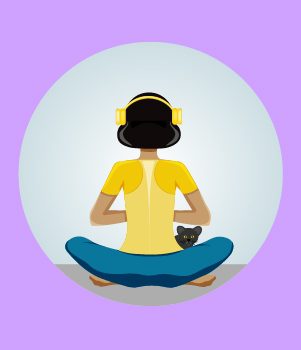
Yoga is a form of exercise that has many health benefits. It can improve your strength, balance, and flexibility. It can also help to relieve pain associated with the back and arthritis.
And, by bringing specific types of music into your yoga session, you’ll be able to improve your overall technique in ways you never thought possible!
- Solfeggio Frequencies: Just like each chakra, each Solfeggio frequency has a unique meaning. Incorporating Solfeggio frequencies into your yoga routine is a great way to strengthen each of your seven chakras, penetrate the subconscious, and bring profound healing properties.
- Gregorian Chants: Using Gregorian chants in your yoga practice is known as “kirtan”. This strengthens your connection to the mind and the heart, increasing human connection, consciousness, and love.
- Meditation Music: Listening to the relaxing tones of meditation music while you practice yoga will help to further relieve stress and anxiety, leaving you feeling fully relaxed and calm at the end of your session. It’s also great for focusing your mind, so it can be used to take you into more difficult poses and help you make more progress.
- Ambient Music: Unlike most other forms of exercise, yoga doesn’t require repetitive physical action. Instead, you’re holding poses and stretching your body. Ambient music is a great background option for yoga since it doesn’t have a repetitive beat. This means you’ll be able to immerse yourself in the music without getting distracted or feeling as though you should be following a beat.
Meditate
Just like yoga, meditation can be both a physical and mental practice that is excellent for focusing your mind, reducing stress, and bringing calm into your life.
There are also specific types of music that can help you reach deeper levels of meditation.

- Meditation Music: Perhaps the most obvious choice, meditation music is ideal for focusing your mind and stopping any other thoughts from entering your head while you’re meditating. It’s also incredibly calming and helps to reduce your cortisol levels
- Solfeggio Frequencies: Listening to Solfeggio frequencies while you meditate will help you connect with and strengthen your chakras. This produces a huge variety of benefits including improved communication skills, liberation from fear, and a return to our spiritual self.
Reduce Stress

Too much stress can lead to a variety of physical and mental health problems, so it’s important to manage it effectively.
Again, music could be the key here, and there are specific types of music that can really reduce our stress levels.
- Isochronic Tones: Listening to isochronic tones with a frequency of 8Hz – 12Hz boosts our Alpha brainwaves. In turn, this helps us feel more relaxed and reduces our stress levels. It can also help to increase our creativity, so if you’re feeling stressed at work due to a lack of creative input, you may find yourself able to think in different ways.
- Meditation Music & Ambient Sounds: No beats, no lyrics, just calming sounds that can transport you to a different place and away from whatever is causing you stress. And, as we’ve already mentioned, meditation music has been proven to lower your cortisol levels. This is the hormone that tells our brains that we are stressed. Dilute this hormone, and you’ll feel both mentally and physically better.
Help Babies Sleep & Brain Development
Getting a baby to sleep at night comes with many trials and tribulations, but using white noise to get them to drift off is a proven and effective method.
The non-threatening noise means that there isn’t any psychological need for your baby to stay awake.

The multiple frequencies also prevent any background noise from waking them up once they are asleep.
It can also promote a feeling of safety which makes it easier for a baby to learn how to self-soothe. It can be used as a distraction from pain or anxiety as well, which can help a baby cope better with the teething process.
Other specific types of music have also been shown to help with a baby’s brain development. This is because repetitive, rhythmic patterns make it easier for the brain to start understanding language.
Relieve Tinnitus
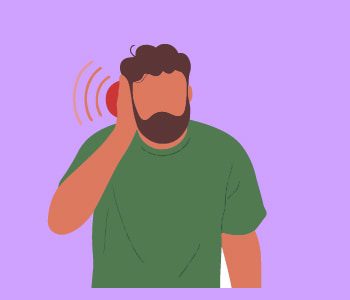
Tinnitus is a high-pitched, ringing sound in either one or both ears.
It’s not only annoying but, in some cases, can create a lot of pain.
It may seem counterintuitive to use music as a form of relief (you’re trying to kill the noise, after all), but there are a couple of specific types of music that can actually help to relieve tinnitus.
- Nature Sounds: Tinnitus is often brought on as a result of trauma or excessive stress, and this can change the way we listen to our surroundings, making our ears work harder and listen more acutely. Playing nature sounds in the background helps to calm the nervous system and, as a result, we aren’t tempted to listen so acutely and the symptoms of tinnitus are reduced.
- Ambient Music: The same principle applies to ambient music. With no repetitive beat and no lyrics, our ears don’t have to listen as acutely. Instead, a relaxing sound is fed into them and that annoying, high-pitched noise that tinnitus produces is dramatically reduced.
Other Health Benefits Of Music

Specific types of music can provide us with all of the above health benefits. But there are even more! Let’s explore these below.
Healthy Heart
That’s right – music can actually boost your heart health. Depending on what you’re listening to, your emotions and mood can be elevated and, in the process, you might feel more energized or calmer.
Music with a fast tempo, in particular, is good for getting your heart pumping and your blood circulating throughout your body.

This is the same basic principle as getting regular exercise. The faster your heart beats, the more calories you burn. Therefore, by listening to music that makes you feel energized, you can keep your heart in good shape.
It is important to note, however, that the effects of music on the heart are minimal and it shouldn’t be considered as a substitute for exercise.
But, it’s a great way to motivate yourself into feeling energized and generally lifting your spirits.
Mood Elevation

Music can also be used to elevate our mood by boosting happiness and reducing anxiety.
A 2013 study found that people that listened to upbeat music found their moods improved and they generally felt happier in as little as two weeks!
And, as mental health and physical health have such a symbiotic relationship, an elevated mood can lead to better physical health.
This is because you’ll feel happier and more energized to go for a walk, workout, or cook yourself something healthy.
Eases the Symptoms of Depression
Music therapy is becoming an increasingly popular tool in the fight against depression. This is because it acts as a neurological stimulator that incites emotions and elevates our mood.
But this isn’t all it does. In fact, the American Music Therapy Association lists a huge variety of benefits that music therapy has on people suffering from anxiety and depression. Here are just a few:

- Increases self-esteem
- Increases motivation
- Reduces muscular tension
- Reduces anxiety
- Helps to release emotions safely and successfully
- Helps to enhance personal relationships
The great thing about music therapy is that there isn’t any right or wrong genre of music, either.
One person suffering from depression might find that they can express themselves and relieve their symptoms by listening to rock, while another may find opera is their preferred music of choice.
Stimulates Memories

While there is no cure for Alzheimer’s, studies have shown that music therapy can also help Alzheimer’s patients recall memories.
One study also found that singing was able to stimulate brain activity in patients suffering from dementia.
Music is such a powerful, memory-evoking tool that even in the later stages of Alzheimer’s, it is possible for a person to tap along perfectly to the beat or sing lyrics to a song they remember from childhood.
This offers a way for many people to connect with a family member that may be suffering from dementia, even when verbal communication has started to become difficult.
Ease Pain and Help to Manage It
Whether you’re undergoing an uncomfortable dental procedure or you’re recovering from a sports injury, music can be an effective way to ease and manage your pain.
This is because, when you listen to music that you love, the neurotransmitter dopamine is released from your brain.

Dopamine is associated with the brain’s reward center, so, while you may be feeling sore, the dopamine that is being released into your body because your brain associates your music with happiness will help to numb the pain.
Music is also a good distraction from pain. This is because it competes for our attention. If you’re thinking about the lyrics or the beat of your favorite song, you’re less likely to be focused on the pain you’re feeling.
Can Help a Person Eat Less

Perhaps you’ve tried every diet on the planet in a bid to lose a few pounds, but nothing seems to work. Have you considered music?
That’s right, rather bizarrely, one of the health benefits that music can offer is the ability to help us eat less!
One study found that certain environmental cues, such as playing relaxing music and softening the lighting, resulted in people eating less. They even rated the food as being more enjoyable.
Of course, this research was carried out in a restaurant environment. But the same principle would apply at home.
So, if you’re trying to lose weight, put on some calming music and dim your lights next time you cook yourself a meal. The evidence goes to show that you’ll feel fuller quicker, eat less, and you’ll enjoy the meal more!
Increased Workout Endurance
Do you enjoy working out but you’re struggling to get to a new personal best? Once again, music could be the answer!
Research undertaken at Brunel University confirms that listening to music while you’re working out can increase your endurance by up to 15%!

But what type of music is best, here? The research shows that upbeat music with a tempo of 120-140 beats per minute is the best choice, and will provide increased results as well as give you the power to exercise for longer.
Soothes Premature Babies

We’ve discussed the wonders of music therapy for people that suffer from depression and Alzheimer’s patients. But did you know that music can also soothe premature babies?
According to this 2013 study, music therapy doesn’t only help a premature baby bond with their parents, but it also improves oxygen saturation, improves heartbeat regulation, increases weight gain, and encourages longer periods of sleep.
All of these add up to a decreased amount of time spent in hospital. This is undoubtedly remarkable. But how does music therapy soothe a premature baby?
Researchers also believe that all babies are born with ‘communicative musicality’. This means that they are able to respond positively to basic musical structures, melodies, and vocals.
As a baby’s hearing begins to develop at 24 weeks old, they are accustomed to hearing their mother’s voice, as well as other family members, while they are in the womb.
Soothing vocals and soft lullabies sung by the voices they are familiar with provide some of the comforts that they would usually have inside the womb.
Helps Children with Autism Spectrum Disorder
Another wonderful thing that music therapy can do is help children with autism spectrum disorder. It does this by improving social behaviors, increasing focus and attention, and reducing anxiety.
It can also help a child with autism to gain a better understanding of words and actions. For example, a song about brushing your teeth, paired with actions, can help them learn how to do this activity.

In fact, research shows that incorporating exercises and movements into songs can help stimulate the nervous system which, in turn, helps some children with autism better develop their fine motor skills.
Mindfulness Practice
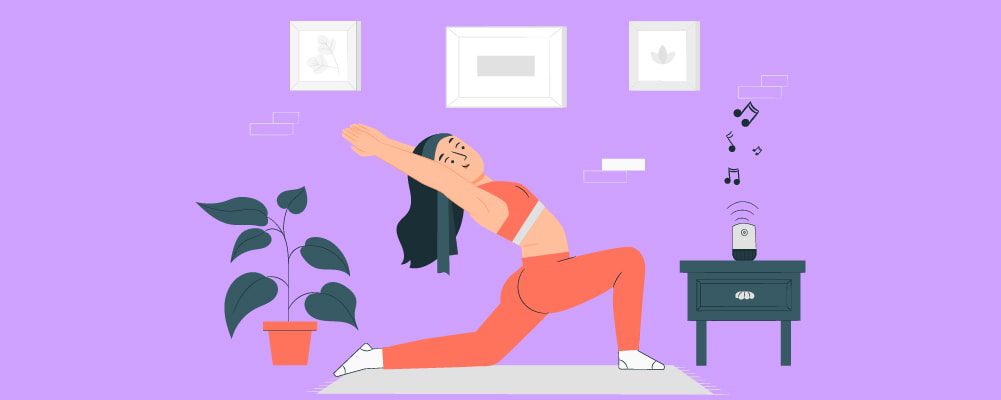
The Impact Of The Pandemic On Our Mental Health
Throughout 2020 and into 2021, everybody in the world found themselves having to deal with the impact of the Coronavirus pandemic.
People lost loved ones, jobs, and life went from being relatively free to being locked indoors for the foreseeable future.
One of the biggest impacts that the pandemic has had is on our mental health, and depression, anxiety, and stress levels were at their highest for many years.
And, even as there seems to be a glimmer of hope appearing at the end of the COVID-19 tunnel, handling these mental health issues is something that many people are still facing.
Throughout this article, you’ll have noticed how music can be a great tool for many things and that its health benefits are untold.
It’s also one of the best tools at your disposal for helping to practice mindfulness and easing any stresses or anxieties you’re feeling because of the pandemic.
But what is mindfulness? To put it simply, it’s a meditation technique that encourages you to notice what’s happening around you at that very moment.
And, while its roots are in Buddhism, you certainly don’t need to be spiritual to practice it. Most of the types of music we’ve listed above are really useful for practicing mindfulness, reducing stress, and elevating our spirits.
Most of them are particularly useful if you’re struggling to get to sleep because you’re unsure of what the future holds.
However, meditation music, brainwave entrainment, and nature sounds are potentially your best options for using music to practice mindfulness.
This is because you’re able to take your mind away somewhere else, whether it’s a remote beach or a walk through the woods.
Doing this gives you a break from the world in a pandemic, calms your mind, and reduces your stress levels.
Conclusion

As you can see, there are loads of health benefits that come from music. There are also a lot of different types of music, some of which you may never have encountered before.
But they all have one thing in common – the ability to relax your mind, reduce stress, and improve your overall health.
If there is one thing you should take away from this article, it’s that specific types of music are better than others at achieving certain things.
If you’re looking for a way to improve your sleep, listening to nature sounds or influencing your brain waves with isochronic tones is a guaranteed way to do it.
Or, if you’re looking for enlightenment and a way to connect with yourself spiritually, Solfeggio frequencies will be your new best friend!
